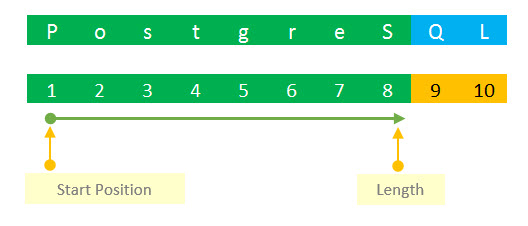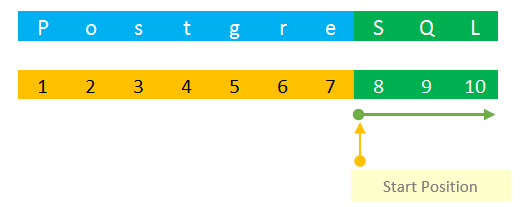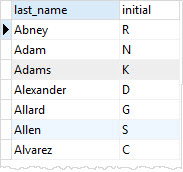August 2, 2023
Summary: in this tutorial, we will introduce you to PostgreSQL substring function that extracts a substring from a string.
Introduction to PostgreSQL substring function
The substring function returns a part of string. The following illustrates the syntax of the substring function:
SUBSTRING ( string, start_position, length )
Let’s examine each parameter in detail:
- string is a string whose data type is char, varchar, text, etc.
- start_position is an integer that specifies where you want to extract the substring. If
start_positionequals zero, the substring starts at the first character of the string. Thestart_positioncan be only positive. Though in other database systems such as MySQL thesubstringfunction can accept a negativestart_position. - length is a positive integer that determines the number of characters that you want to extract from the string beginning at
start_position. If the sum ofstart_positionandlengthis greater than the number of characters in thestring, the substring function returns the whole string beginning atstart_position. The length parameter is optional. If you omit the length parameter, the substring function returns the whole string started atstart_position.
PostgreSQL substring examples
See the following examples:
SELECT
SUBSTRING ('PostgreSQL', 1, 8); -- PostgreS
SELECT
SUBSTRING ('PostgreSQL', 8); -- SQL
In the first statement, we extract a substring that has length of 8 and it is started at the first character of the PostgreSQL string. we get PostgreS as the result. See the following picture:

In the second statement, we extract a substring started at position 8 and we omit the length parameter. The substring is a string beginning at 8, which is SQL.

PostgreSQL provides another syntax of the substring function as follows:
substring(string from start_position for length);
In this form, PostgreSQL puts three parameters into one. See the following example:
SELECT
SUBSTRING ('PostgreSQL' FROM 1 FOR 8); -- PostgreS
SELECT
SUBSTRING ('PostgreSQL' FROM 8); -- SQL
The results are the same as the one in the first example.
In the following example, we query data from the customer table. We select last_name and first_name column. We get the initial name by extracting the first character of the first_name column.
SELECT
last_name,
SUBSTRING( first_name, 1, 1 ) AS initial
FROM
customer
ORDER BY
last_name;

Extracting substring matching POSIX regular expression
In addition to the SQL-standard substring function, PostgreSQL allows you to use extract a substring that matches a POSIX regular expression. The following illustrates the syntax of the substring function with POSIX regular expression:
SUBSTRING(string FROM pattern)
Or you can use the following syntax:
SUBSTRING(string, pattern);
Note that if no match found, the substring function return a null value. If the pattern contains any parentheses, the substring function returns the text that matches the first parenthesized subexpression.
The following example extracts the house number (maximum 4 digits, from 0 to 9) from a string:
SELECT
SUBSTRING (
'The house no. is 9001',
'([0-9]{1,4})'
) as house_no

Extracting substring matching a SQL regular expression
Besides POSIX regular expression pattern, you can use SQL regular expression pattern to extract a substring from a string using the following syntax:
SUBSTRING(string FROM pattern FOR escape-character)
This form of substring function accepts three parameters:
string: is a string that you want to extract the substring.escape-character: the escape character.pattern: is a regular expression wrapped inside escape characters followed by a double quote ("). For example, if the character#is the escape character, the pattern will be#"pattern#". In addition, thepatternmust match the entirestring, otherwise, the substring function will fail and return aNULLvalue.
See the following examples:
SELECT SUBSTRING (
'PostgreSQL'
FROM
'%#"S_L#"%' FOR '#'
); -- SQL
SELECT SUBSTRING (
'foobar'
FROM
'#"S_Q#"%' FOR '#'
); -- NULLL
PostgreSQL provides another function named substr that has the same functionality as the substring function.
Summary
- Use the PostgreSQL substring functions to extract substring from a string.

